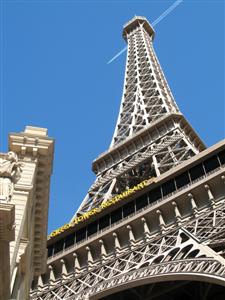JUNE 2007 TRUCKER TALK
THE EVER-CHANGING
LAS VEGAS
By Writers and Owner
Operators Rod & Kim Grimm
It’s hard to imagine that prehistoric Nevada was once a virtual marsh of abundant water and vegetation. Las Vegas means “The Meadows” in Spanish, but looking there today, meadows might not be exactly what you see. It has since evolved into a parched and arid landscape with the water trapped underground. But that is not the only change this area has seen, for Las Vegas is a city that never stops redefining itself.
In 1830 Mexican trader Antonio Armijo, leading a 60-man party, veered off the route of the Spanish Trail to Los Angeles. His caravan camped about 100 miles northeast of present day Las Vegas. A scouting party rode west in search of water. Rafael Rivera left the main party and ventured into then unexplored desert. Within two weeks, he discovered Las Vegas Springs. The exact date is unknown, but he became the first known non-Indian to set foot in the oasis-like Las Vegas Valley. Let the changing begin.
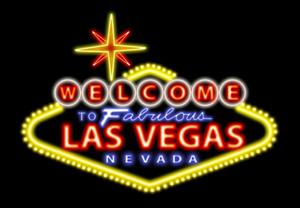 Fourteen
years after Rivera’s discovery, John C. Fremont led a survey party west
and camped at Las Vegas Springs on May 13, 1844. Today, his infamous name
is remembered in museums, history books and neon. The Fremont Hotel &
Casino in downtown Las Vegas, as well as Fremont Street, the main thoroughfare
through the heart of casino-lined Glitter Gulch, were both named after
him.
Fourteen
years after Rivera’s discovery, John C. Fremont led a survey party west
and camped at Las Vegas Springs on May 13, 1844. Today, his infamous name
is remembered in museums, history books and neon. The Fremont Hotel &
Casino in downtown Las Vegas, as well as Fremont Street, the main thoroughfare
through the heart of casino-lined Glitter Gulch, were both named after
him.
By 1890 railroad developers decided that the water-rich Las Vegas Valley would be a prime location for a train station. No one back then could have imagined what would grow out of the “tent town” they called Las Vegas. The new town sprouted saloons, stores and boarding houses, which eventually led to the official founding of the city on May 17, 1905. Soon thereafter, 1,200 lots were auctioned off in an area that is today lined with casinos, as Las Vegas began to change and grow again.
Nevada was the first U.S. state to legalize casino-style gambling, but not before it had been the last western state to outlaw the activity in the first decade of the 20th century. A strict anti-gambling law became effective at midnight on October 1, 1910. This law even made the western custom of flipping a coin for the price of a drink illegal. The Nevada State Journal newspaper in Reno reported, “Silenced forever is the click of the roulette wheel, the rattle of dice and the swish of cards.” Well, “forever” did not last long. Gamblers quickly went underground and patrons, knowing the proper password, could still play with Lady Luck.
In 1931 gambling was still illegal in Nevada but it was flourishing, so the legislature approved a legalized gambling bill. Legalized gambling returned to Nevada during the Great Depression. Later that year, the construction began on Hoover Dam. The young city of Las Vegas was virtually insulated from the economic hardships most Americans were facing. Both money and jobs were prevalent because of the Union Pacific Railroad development, legalized gambling and the construction of Hoover Dam 34 miles to the east in Black Canyon on the Colorado River. Again, Las Vegas began to evolve and change.
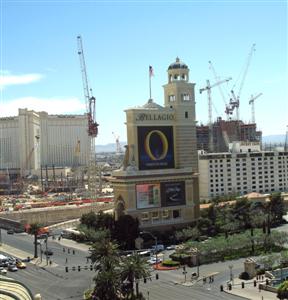 WWII
stalled major resort growth, but the seeds for future expansion were planted
in 1941 when hotelman Tommy Hull built the El Rancho Vegas Hotel &
Casino across from the present site of the Sahara. El Rancho Vegas’ success
triggered a small building boom in the late 1940’s, including construction
of several new hotel-casinos fronting a two lane highway leading into
Las Vegas from Los Angeles, CA. This stretch of road evolved into today’s
Las Vegas Strip. Early hotels here included the Last Frontier and the
Thunderbird.
WWII
stalled major resort growth, but the seeds for future expansion were planted
in 1941 when hotelman Tommy Hull built the El Rancho Vegas Hotel &
Casino across from the present site of the Sahara. El Rancho Vegas’ success
triggered a small building boom in the late 1940’s, including construction
of several new hotel-casinos fronting a two lane highway leading into
Las Vegas from Los Angeles, CA. This stretch of road evolved into today’s
Las Vegas Strip. Early hotels here included the Last Frontier and the
Thunderbird.
The Flamingo was the most celebrated of the early resorts, built by Benjamin “Bugsy” Siegel, a member of the Meyer Lansky crime organization. On New Year’s Eve 1946, The Flamingo opened with a giant pink neon sign and replicas of pink flamingos on the lawn. Six months later, Bugsy was murdered in the Beverly Hills home of his girlfriend Virginia Hill. Unlike most of the other resorts back then, which had a western theme, The Flamingo was what Siegel called a “carpet joint” – it was modeled after the resort hotels in Miami.
The 1950’s saw accelerated resort building. In 1950, the Desert Inn opened, followed by the Sands Hotel in 1952. Just down the street, in the old Downtown area, the Fremont Hotel & Casino was opened. Other 50’s resorts included the Dunes, Hacienda, Tropicana and the Stardust on the Strip.
In the 1940’s, the El Rancho Vegas was the only resort on the Las Vegas Strip that booked a wide variety of performers to entertain hotel guests in small, intimate showrooms. Later, in the 1950’s, the Stardust was the first hotel to begin debuting big stars as its main entertainment feature. And so began another era. This resort once even imported the Lido de Paris from France, which the critics raved as being a more spectacular version than the original in Paris. Minsky’s Follies, which debuted at the Dunes in 1957, was the first topless revue. Not long after that, the Tropicana Hotel bought the rights to the Folies Bergere, a topless extravaganza that still runs today.
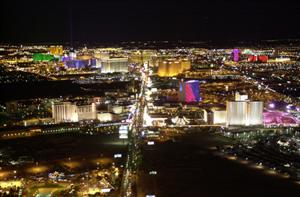 Also
in the 1950’s, city and community leaders realized the need for a Las
Vegas Convention Center. One block east of the Las Vegas Strip, a 6,300-seat
silver domed rotunda with a 90,000 square foot exhibit hall opened in
April of 1959. In 1990 the silver dome was demolished to make room for
the 1.6 million square foot expansion (of which 1.3 million square feet
is exhibit space) which today is the home of the Las Vegas Truck Show.
The Las Vegas Convention Center is supported mainly by room revenues and
is a major player in attracting visitors as convention delegates to Las
Vegas.
Also
in the 1950’s, city and community leaders realized the need for a Las
Vegas Convention Center. One block east of the Las Vegas Strip, a 6,300-seat
silver domed rotunda with a 90,000 square foot exhibit hall opened in
April of 1959. In 1990 the silver dome was demolished to make room for
the 1.6 million square foot expansion (of which 1.3 million square feet
is exhibit space) which today is the home of the Las Vegas Truck Show.
The Las Vegas Convention Center is supported mainly by room revenues and
is a major player in attracting visitors as convention delegates to Las
Vegas.
Casino lounges provided continuous entertainment in the 50’s & 60’s at no charge to the customer (except for the price of a drink). These lounges became major entertainment attractions in their own right. But like everything else in Las Vegas, that too has changed. Now major attractions have major ticket prices – and they aren’t held in an intimate setting but on elaborate stages with spectacular special effects.
In the 60’s, multiple coin slot machines made their debut. Mechanical nickel and penny machines that took only one coin at a time evolved into the popular computerized dollar slots, capable of accepting multiple coins. Jackpots grew from a few hundred dollars to over a million. Video gaming machines were introduced in the 1970’s, replacing spinning reels with video screens. These new machines, featuring games like poker, keno, black jack, craps and bingo, gained popularity quickly.
When Atlantic City, NJ legalized casino-style gambling in 1976, Las Vegas realized they no longer could claim exclusive rights to gambling casinos. That realization ushered in the next big change for Las Vegas – the beginning of the mega-resort era on the Strip. Circus Circus Enterprises Inc. had already opened a circus-tent-shaped casino in 1968 with midway games and rides for youngsters, and in 1972 they added a hotel. The Mirage opened in the fall of 1989, followed by the Excalibur in 1990 and the MGM Grand in 1994.
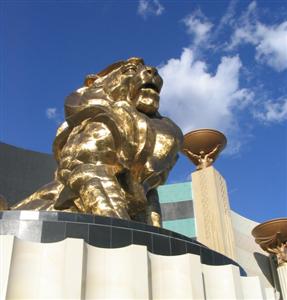 In
1993 an extravagant project called “The Fremont Street Experience” was
launched to help downtown keep pace with the booming Strip. The plan added
a roof over the street between the casinos and an amazing laser light
and sound show. Fremont Street has come a long way from being the city’s
first paved street in 1925 with one traffic light, to being one of the
most popular tourist destinations in the world. Downtown Las Vegas had
36 years of history built before the El Rancho Vegas became the first
casino on the Strip in 1941. But oh how things do change – especially
in Las Vegas.
In
1993 an extravagant project called “The Fremont Street Experience” was
launched to help downtown keep pace with the booming Strip. The plan added
a roof over the street between the casinos and an amazing laser light
and sound show. Fremont Street has come a long way from being the city’s
first paved street in 1925 with one traffic light, to being one of the
most popular tourist destinations in the world. Downtown Las Vegas had
36 years of history built before the El Rancho Vegas became the first
casino on the Strip in 1941. But oh how things do change – especially
in Las Vegas.
On June 17, 1960 the historic El Rancho Vegas was razed by fire. As time went on, many other first-generation strip resorts became absorbed by new owners, demolished, or over went extensive renovations and name changes. And with every great beginning, comes an even greater ending – at least in Las Vegas. Beginning with the Dunes in 1993, the era of Las Vegas implosions began. Making way for bigger and better resorts, the fiery implosions have become major television events – and another page in the history of Las Vegas. From the Dunes in 1993 to just recently the Stardust in 2007, some nine or so famous hotels have been leveled, including the Landmark, Sands, Hacienda, Aladdin and Desert Inn.
Today, the Strip offers everything from The Eiffel Tower at Paris to the famous landmarks of New York. Want to see sharks? Head on down to Shark Reef at Mandalay Bay. Want to sleep in an Egyptian pyramid or a medieval castle – the Luxor and Excalibur resorts await you. There is also a volcano that erupts hourly, a choreographed pirate attack, white tigers, a huge lake with dancing water, roller coasters, spectacular shows, world-class shopping and dining, and, of course, a few casinos.
And if you want to get a birds-eye view of it all, go to the top of the Stratosphere Tower. At 1,149 feet, the Stratosphere is the tallest observation tower in the United States. The panoramic scene from the 109th-floor deck is truly spectacular – especially at night – the view of the city and it’s ocean of lights is amazing. While there you can also dine in a restaurant that revolves, giving you an ultimate dining experience. And after a relaxing dinner, you can go up on the roof of the tower and ride a roller coaster around the outside of the building. I’ve done once, and it’s pretty cool! No fast turns, just a slow ride with a great view. Of course, they also have mind-bending, hair-raising, stomach-churning rides up there too, but why waste that expensive dinner you just enjoyed in the revolving restaurant.
Las Vegas has been called “Sin City” and “the city that never sleeps,” but its true claim to fame is the fact that it is a city that never stops changing. From a “tent city” rail station to one of the most exciting, fun, fastest growing cities in the world, Las Vegas continues to adapt and evolve into a city people want to live in and visit, over and over again. If you haven’t been to Las Vegas in ten years or more, you really haven’t been there at all – there is little there that you would recognize today. And we can’t even imagine what the city will look like ten years from now, and all of the changes that are still yet to come.
Copyright
© 2006 10-4 Magazine and Tenfourmagazine.com
PO Box 7377 Huntington Beach, CA, 92615 tel. (714) 378-9990 fax
(714) 962-8506

